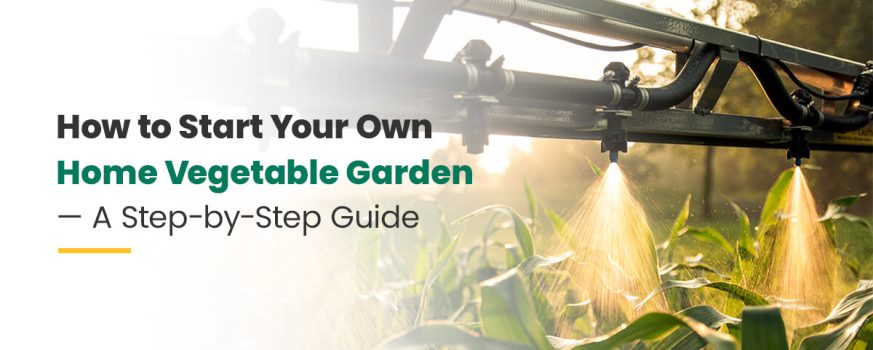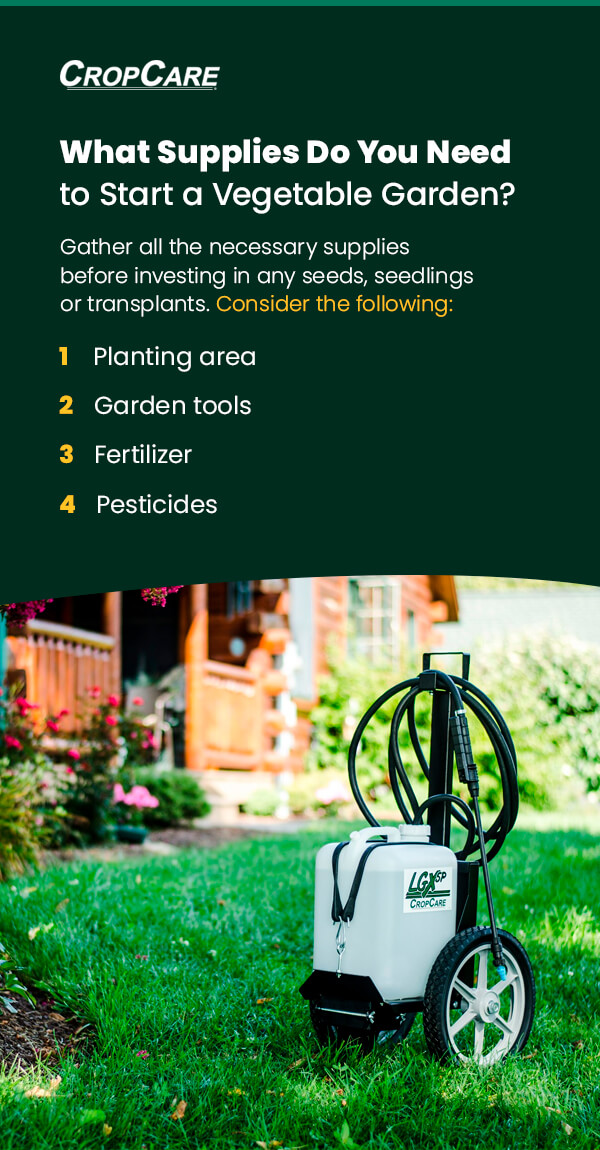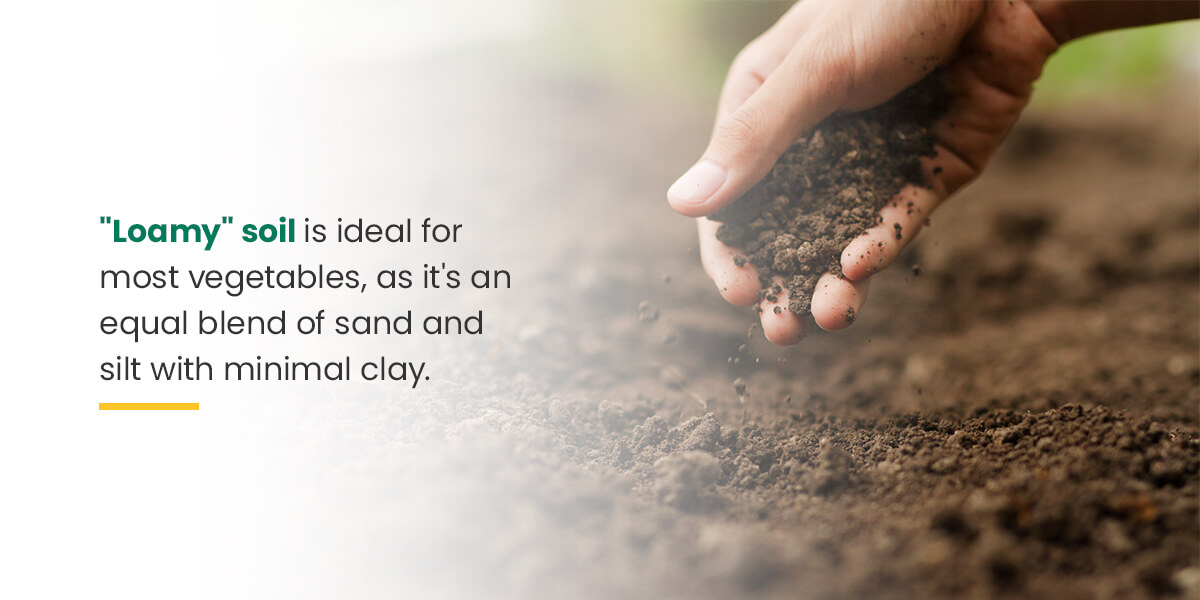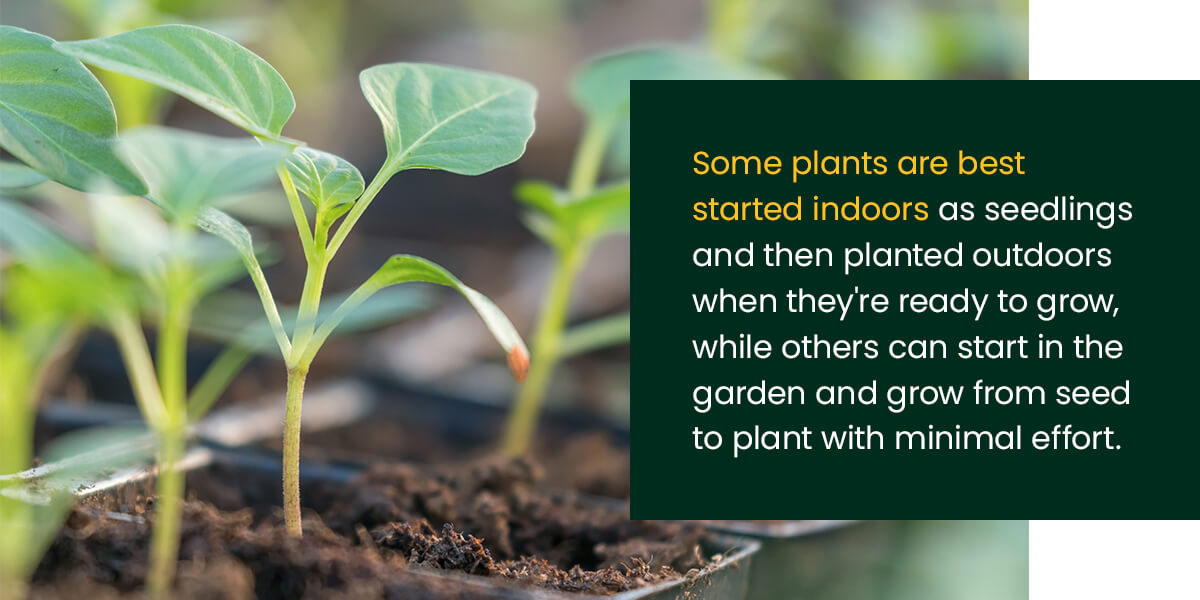
Growing a vegetable garden in your backyard is an engaging, rewarding way to beautify your outdoor space and spend more time in the sunshine and fresh air. It’s also a hobby that pays off — homegrown vegetables are nutritious and save you the cost and environmental impact of shopping for produce at a grocery store. You retain full control over each step of your vegetables’ growing process, including where you source the seeds, what fertilizers you apply and how often you want to harvest them for a delicious meal!
The internet is full of resources about vegetable gardening for beginners, but all the information can be overwhelming for someone new to DIY growing. We’ve compiled a step-by-step guide with all the basic information you need to help you start a thriving garden at home.
What Supplies Do You Need to Start a Vegetable Garden?
Gather all the necessary supplies before investing in any seeds, seedlings or transplants. Some parts of garden preparation, like your planting area, might take a few days or weeks before it’s ready for planting.
Consider the following:
- Planting area: The larger your planting area, the more room you’ll have to grow a bigger vegetable selection. The space should have access to about six hours of sunlight per day, depending on the plants you choose, and should be free of excessive roots or rocks. Some plants may also require specific amounts of shade throughout the day. Consider additional space for protective fencing and raised beds if needed.
- Garden tools: Useful garden tools to have on-hand include a hoe, a large shovel, a small hand trowel, pruning shears, gardening gloves, a watering can, plant stakes or labels, harvesting containers, mulch liners and growing cages, if applicable.
- Fertilizer: Most vegetables thrive on a regular fertilization schedule. Options include commercial bagged mixtures or spray-on solutions. You can also fertilize plants with compost, like animal manure, food scraps, worm castings and other organic matter.
- Pesticides: Though certain steps can minimize your chance of attracting vegetable pests, many gardeners will eventually deal with them in some capacity. Ensure any pesticides you use are safe for children and pets, and don’t apply them without protective equipment over your skin, eyes and mouth. Always follow the manufacturer’s instructions printed on the container.
Choose a Location for Your Home Garden
Your vegetable garden should be close enough to your home to easily water and monitor for trampling wildlife, and it will only thrive in healthy growing conditions.
Pick the Right Spot
Your garden should be located near a water source, like a garden hose, but not too close to a pond or depressed area where water may pool or have poor drainage. The ground should be either level or gently sloped, and you should avoid planting at the bottom of a hill.
Nearby structures, like sidewalks, buildings, hedges, fences and trees, could interfere with water runoff and sunlight or shade availability. Establish your garden in an area with minimal preexisting plants, trees and shrubs. Otherwise, your vegetables may have to compete with stronger, more established plants for the nutrients they need to survive.
Design Your Setup
Design your ideal garden setup with one of the following:
- Standard garden beds: Standard garden beds are tilled areas of dirt where you plant seeds or transplants directly into the ground in the existing dirt. You can fit one of these in any patch of healthy ground, no matter how small your yard space, and you can easily remove them if needed. Standard garden beds are also a simple, economic decision with minimal costs involved to start. Although you have less control over the soil quality, it’s easier for plants to hold water longer.
- Raised garden beds: Raised garden beds are just like they sound — gardens planted in raised boxes, often framed with wood, that give you full control over the soil and growing process. Raised garden beds let you put a garden somewhere you wouldn’t otherwise have access to dirt, like a patio or porch, and they keep plants safer from trampling animals and erosion.
- Greenhouses: Greenhouses are a more significant financial investment, but they may be the best choice if you want optimal temperature control and protection from animals and weather. Glass greenhouses are the most common and let you grow various plants throughout the year regardless of their seasonality.
Although some soft lighting will make the garden easier to see after dark, be careful not to place them too close to the plants, leaves or roots, or the heat could dry them out or interfere with their light absorption.
Plan the Layout
Your layout mostly depends on the specific plants you’re growing. Some vegetables are more adaptable, while others require very specific growing conditions to survive. A few options include vertical or horizontal rows, squares, blocks or grouping plants by square footage.
Some general tips for your layout include:
- Research your vegetables to learn which ones may complement each other’s growth and which may compete for nutrients.
- Keep sunlight placement and access in mind for each plant. Avoid planting taller vegetables where they could cast shadows on smaller ones.
- Learn the required planting soil depth, seed density and spacing for each vegetable.
- Consider planting in a tall to midsize to short height order.
- Fertilize according to individual nutritional needs. Heavy feeders, like leafy greens, need more nutrients than middle feeders, like tomatoes, or minimal feeders, like potatoes.
- Add some pollinating flowers or plants near your vegetables to attract helpful insects that will protect plants against more harmful ones.
- Rotate crop locations each year for maximum plant health.
How to Prepare Your Soil for Vegetable Gardening
“Loamy” soil is ideal for most vegetables, as it’s an equal blend of sand and silt with minimal clay. Too much silty or sandy soil won’t allow the roots to take hold, but a balanced amount promotes aeration to avoid root suffocation.
Perform a soil test to start a vegetable garden from scratch:
- Dig a temporary hole in your planting area. Aim for 1 foot deep, 1 foot wide and 1 foot long. You can fill this hole again when you’re finished testing the soil.
- Fill the test hole with a half-gallon of water, carefully pouring it slowly enough not to overfill or create spillage.
- Time how long the hole takes to drain. It may take hours, which is typically acceptable, but it’s not adequate drainage if the water takes days to drain or pools under the surface.
You should also test your soil for its pH balance for a better idea of what growing challenges might be at play. Examples include aeration issues, fungus, diseases, hidden weeds that consume nutrients and invisible pests. Many local environmental agencies and university centers offer free or low-cost soil testing for acid, nitrogen, phosphorus and potassium levels. Test the soil beyond your specific garden area if you’re planting vegetables with extensive root systems, which could extend beyond garden confines.
Choosing Vegetables for Your Garden
Ultimately, the vegetables you plant should be ones you’re excited to eat or sell. But all the excitement in the world won’t matter if your vegetables aren’t compatible with your climate, planting season and growing conditions.
Vegetables by Season
Vegetables are typically either cold-season or warm-season plants.
Cool months include early spring, winter and late autumn, depending on which part of the country you live in. Examples on cold-season plants include:
- Arugula
- Beets
- Broccoli
- Brussels sprouts
- Cabbage
- Cauliflower
- Garlic
- Kale
- Kohlrabi
- Leeks
- Onions
- Parsnips
- Peas
- Potatoes
- Spinach
Warmer months, like late spring, summer, early autumn, are ideal for vegetables like:
- Beans
- Corn
- Cucumbers
- Eggplants
- Melons
- Peppers
- Squash
- Sweet potatoes
- Tomatoes
Difficulty
If you’re a beginning gardener or don’t have a lot of time and resources to dedicate to your garden, stick to vegetables like:
- Cucumbers
- Green beans
- Kale
- Lettuce
- Peas
- Radishes
- Spinach
- Squash
If you’re an experienced gardener or a beginner up for a challenge, consider:
- Artichokes
- Celery
- Eggplants
- Onions
- Sweet corn
- Tomatoes
Hardiness Zone
The United States Department of Agriculture (USDA) issued a map dividing the country into three different growing regions, including multiple subsets within those regions, to help gardeners know which plants will most likely thrive in a specific area. The map considers temperature, terrain conditions and other growth factors.
You can search your growing zone on the map via zip code or state.
Special Considerations
Some plants have special growing requirements to consider. For example, tomatoes often require cages or growing structures to stay lifted from the ground, and artichokes are more susceptible to pest infestation.
Let these tips guide you through your first garden season:
- Consider using a starter solution spray to aid new plant growth.
- Use mulch to protect soil and discourage weed growth.
- Clean your garden between seasons to inspect for weeds, pests and leftover growth.
- Gather all old plants and burn, till or compost them before each new growing season.
- Research your chosen vegetable to learn its most effective growing conditions and care tips and to troubleshoot common concerns like dry spots, stunted growth, rot or yellowing.
How to Plant Your First Seeds
Start with quality seeds, seedlings or transplants. The best quality options are available at local markets, farms and greenhouses. While the seeds and starters at mass-market retailers will work, they aren’t usually as high quality and haven’t been grown as carefully with consideration to pests, sunlight and moisture.
Some plants are best started indoors as seedlings and then planted outdoors when they’re ready to grow, while others can start in the garden and grow from seed to plant with minimal effort. You can find growing instructions on the seed packet, online or by talking with your local arborist or landscaper.
Note the depth you should plant the seed, ideal spacing between each plant and what temperature is ideal for starting them outdoors. Always plant warm-season vegetables after the last frost. Invest in cloches and row covers as needed to protect vulnerable plants from unexpected freezing temperatures or frost.
After placing seeds in their respective holes, cover them with a layer of firm soil, being careful not to compact the dirt too tightly. Moisten the top with a fine mister or light drip from the watering can.
Post-planting instructions vary. Encourage seed germination by keeping the area protected. Follow the recommended watering and sunlight routines, and be prepared to give your new seeds extra care and attention until they start sprouting. They are at their most vulnerable until their roots take hold.
Ongoing Care for Your Vegetables
You’ve done a lot of work so far, but growing healthy vegetables is an ongoing process — the effort is worth it when you watch your seedlings grow from sprouts to a produce drawer full of fresh veggies.
Maintaining your vegetable garden includes:
- Sticking to a watering schedule: Stick to a consistent watering schedule appropriate for each vegetable type. They don’t all get the same amount of water, and many plants need to have dry soil between waterings. Never water vegetables in harsh sunlight, like during the afternoon. Stick with early mornings or as the sun goes down. Mist or pour water onto the soil and roots and mist leaves as needed. Know the signs of overwatering and underwatering, including wilting leaves, discoloration and root rot.
- Knowing the warning signs: Keep an eye on your vegetables for common warning signs of diseases, such as wilting, sunspots, discoloration, holes, abnormal marks and plants falling from vines before maturity.
- Using nutritional supplements: Use fertilizers as needed for optimal growth, usually every three to four weeks. While dry fertilizers are nutrient-rich, liquid fertilizers offer the same benefits but are faster acting and promote a more even application. Use a quality fertilizer sprayer that can protect rows while spraying and offers pressure control.
- Implementing pest prevention: Use pest prevention methods like consulting a professional pest management company or using food-safe pesticides if you notice signs like chew marks, holes in the leaves, stem damage near the soil, yellowing and visible bugs or worms.
Start Your Vegetable Garden With Supplies From CropCare®
CropCare® offers built-to-order and tried-and-true agricultural sprayers for small and midsize farms and gardens. Our equipment comes with helpful features like special shields to protect plants you want to keep dry, specific application pressures and spray speed control. We can also help you with vegetable farming equipment like mulching accessories and picking assistants. All purchases include a free quote and technical support. Find a dealer near you to get started!





